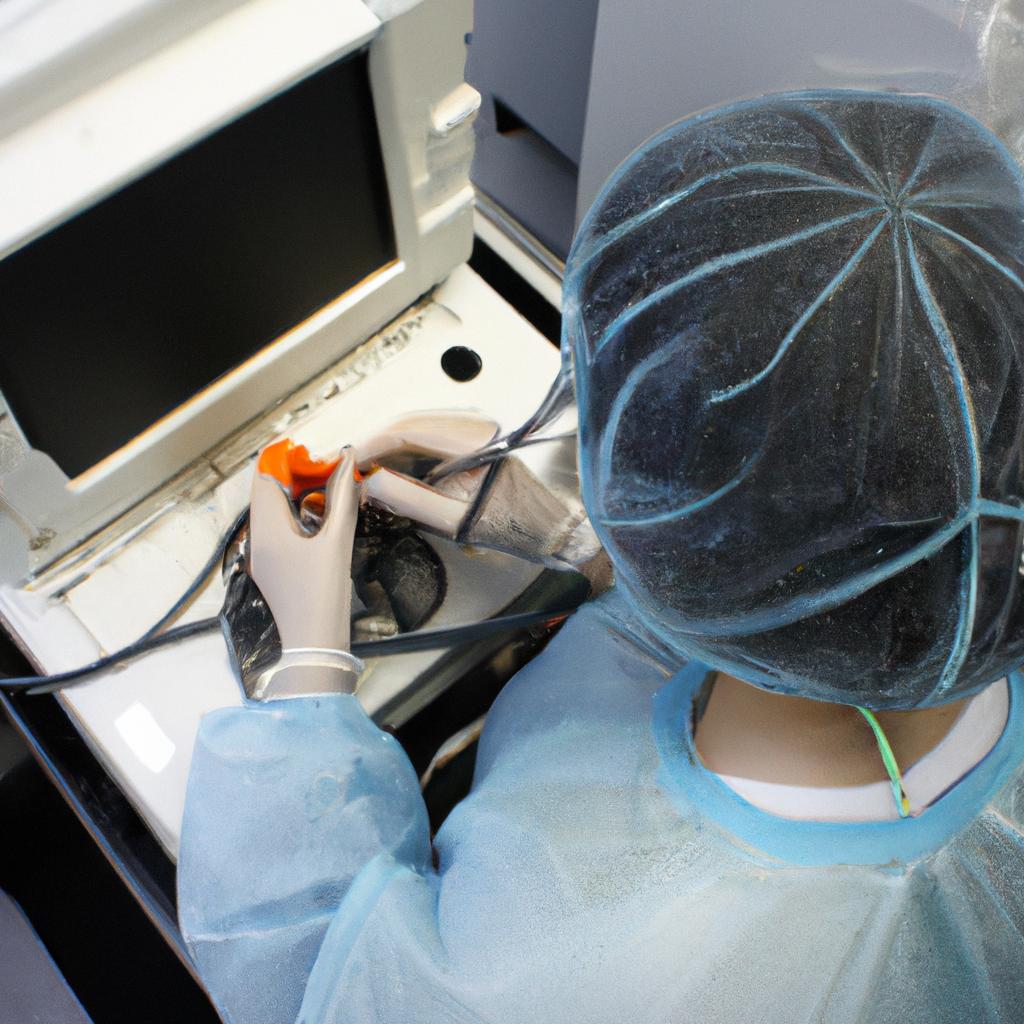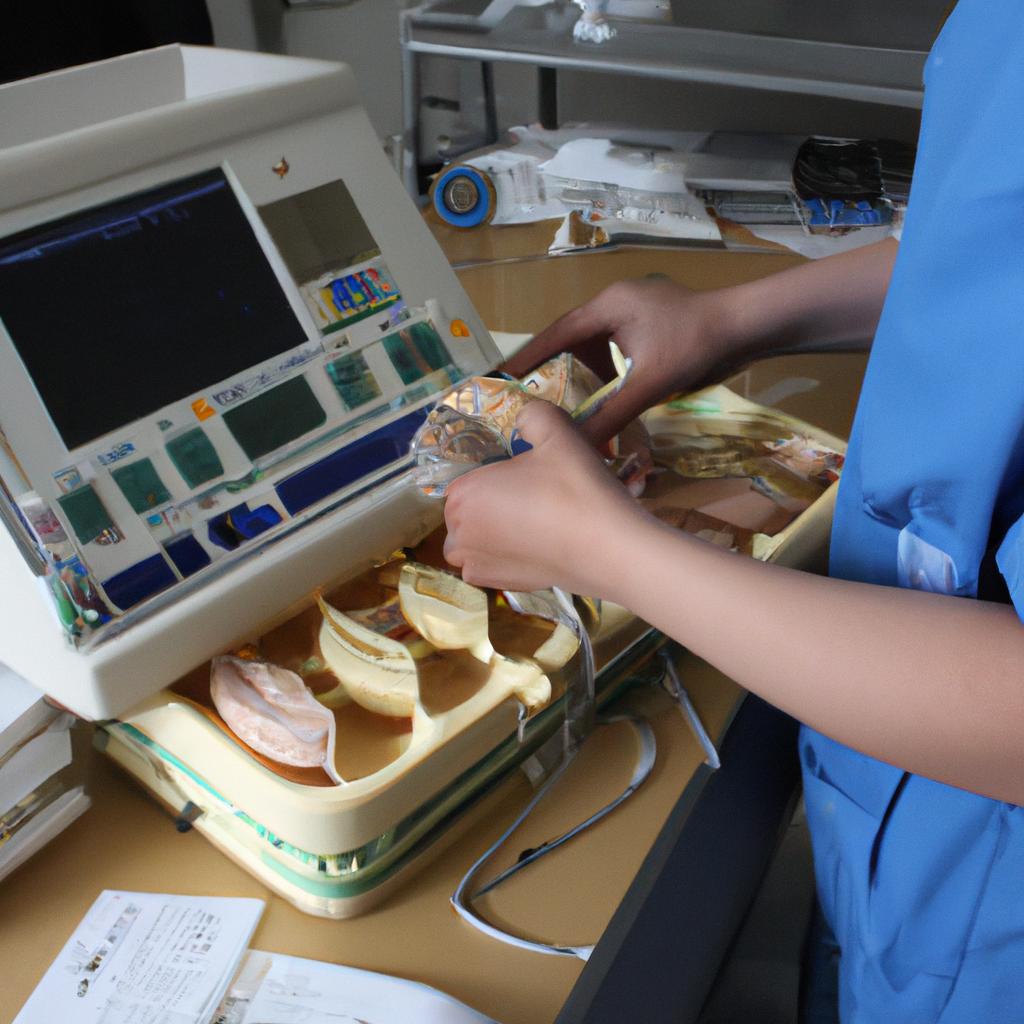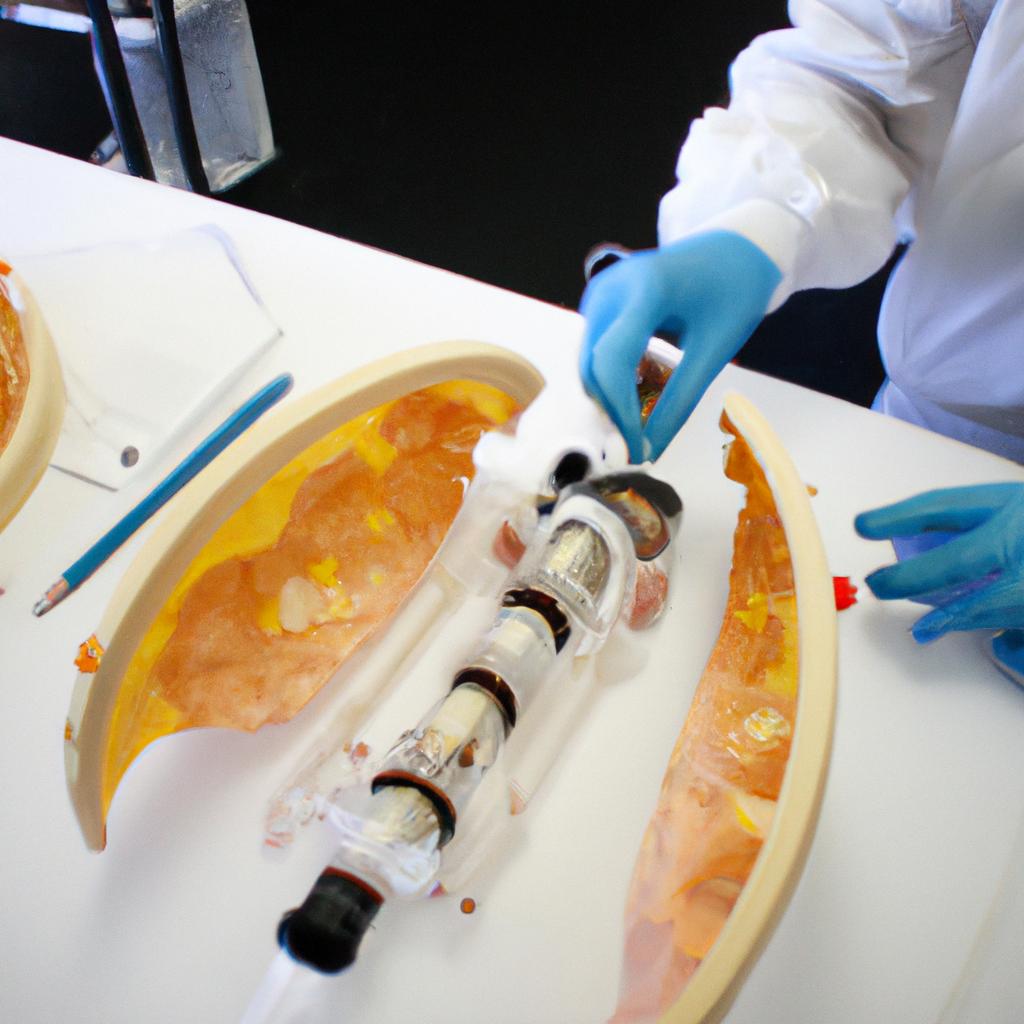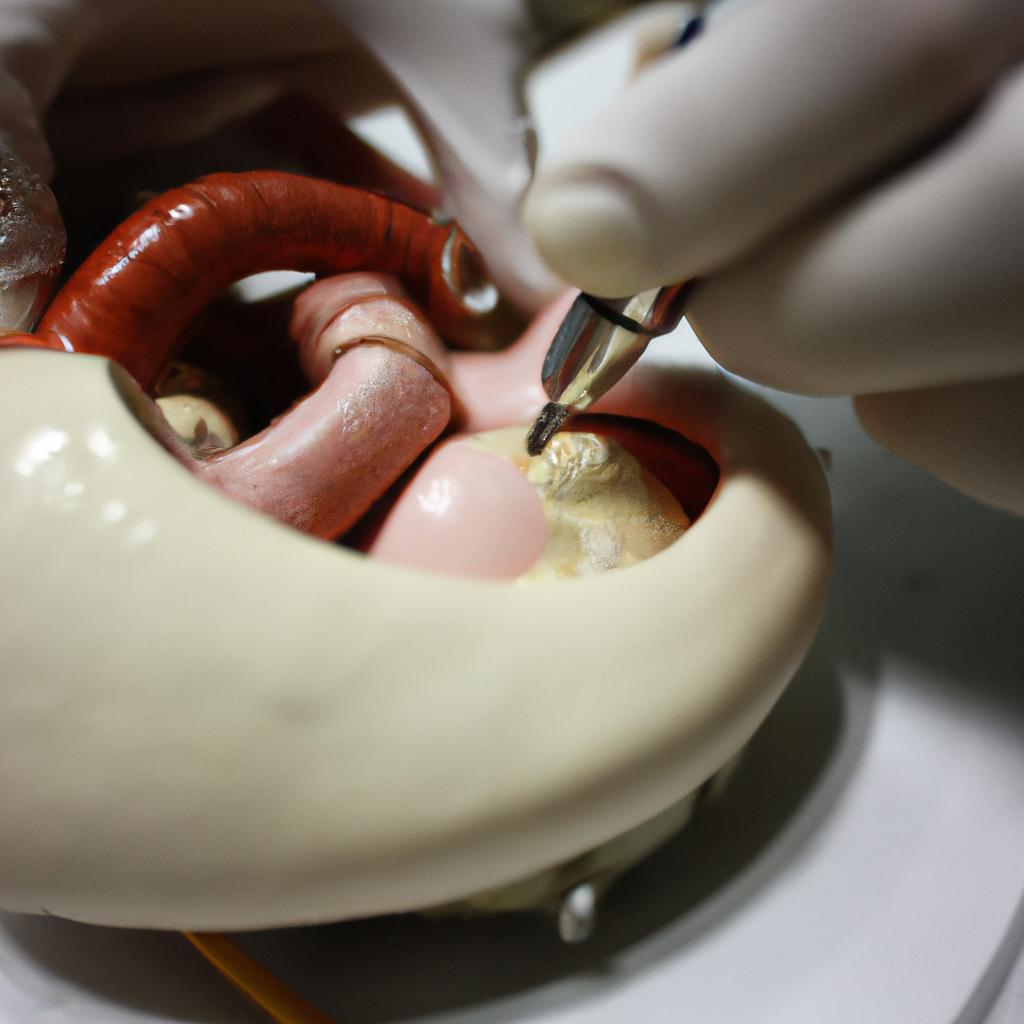In recent years, engineering has revolutionized the field of medicine by enabling the development of artificial organs. One noteworthy advancement is the creation of an artificial pancreas, which holds great promise for individuals with diabetes. Imagine a world where people no longer have to meticulously monitor their blood sugar levels or administer insulin injections multiple times a day. This article explores the impact and potential benefits of engineering in medicine through the specific lens of the artificial pancreas.
The story begins with Sarah, a 35-year-old woman who was diagnosed with type 1 diabetes at a young age. Despite her best efforts to manage her condition, Sarah often struggled to maintain stable blood glucose levels due to variations in diet and physical activity. Her daily routine involved frequent blood tests and insulin injections, disrupting both her personal and professional life. However, thanks to advancements in engineering, Sarah’s life took a dramatic turn when she became one of the early recipients of an artificial pancreas prototype.
Understanding the Artificial Pancreas
Imagine a world where individuals with diabetes no longer have to constantly monitor their blood sugar levels or administer insulin injections. This scenario is becoming increasingly plausible thanks to the development of artificial pancreas systems, which aim to automate and improve glycemic control for people living with diabetes.
The artificial pancreas acts as an integrated closed-loop system that mimics the function of the human pancreas by continuously monitoring glucose levels in the body and automatically delivering precise doses of insulin as needed. By combining continuous glucose monitoring (CGM) technology with an insulin pump, this innovative device holds great promise in revolutionizing diabetes management.
To fully comprehend the significance of artificial pancreas systems, it is necessary to explore some key aspects surrounding their implementation:
- Improved Glycemic Control: One of the primary goals of using an artificial pancreas system is to achieve better glycemic control. Maintaining stable blood sugar levels within a target range can help reduce the risk of short-term complications such as hypoglycemia or hyperglycemia while mitigating long-term health issues associated with poorly managed diabetes.
- Enhanced Quality of Life: Managing diabetes requires constant vigilance and decision-making regarding food intake, physical activity, medication dosage adjustments, and stress factors affecting blood sugar levels. The introduction of artificial pancreas technology alleviates some of these burdensome tasks by automating insulin delivery based on real-time glucose readings.
- Reduced Hypoglycemia Risk: Hypoglycemia, characterized by low blood sugar levels, poses significant dangers for individuals with diabetes. By closely monitoring glucose concentrations and adapting insulin dosing accordingly, artificial pancreas systems can effectively minimize the occurrence of hypoglycemic events.
- Preventive Health Measures: Consistent maintenance of optimal blood glucose levels through an artificial pancreas system may potentially lead to reduced risks of developing secondary complications associated with diabetes, such as cardiovascular diseases and kidney damage.
To grasp the potential impact of artificial pancreas systems further, consider the following table:
| Benefit | Description | Emotional Response |
|---|---|---|
| 1 | Enhanced glycemic control | Relief |
| 2 | Simplified diabetes management | Hope |
| 3 | Decreased risk of hypoglycemia | Reassurance |
| 4 | Mitigation of long-term complications | Empowerment |
In summary, the development of artificial pancreas technology represents a significant advancement in medicine. By simulating the function of a healthy human pancreas, these systems offer improved glycemic control, enhanced quality of life, reduced hypoglycemia risks, and preventive health measures for individuals living with diabetes.
Understanding the benefits provided by artificial pancreas systems sets the stage for exploring their numerous applications within medical practice. In the subsequent section on “Benefits of Artificial Pancreas in Medicine,” we will delve into how this innovative technology can positively transform healthcare delivery and patient outcomes without any abrupt transitions.
Benefits of Artificial Pancreas in Medicine
Advancements in Artificial Organs: The Potential of the Artificial Pancreas
The story of John, a 34-year-old diabetic patient, illustrates the transformative potential of artificial pancreas technology. John had struggled for years with managing his blood sugar levels, often experiencing dangerous fluctuations that required immediate medical attention. However, after receiving an artificial pancreas implant, his life changed dramatically. With this innovative device continuously monitoring and regulating his glucose levels, John regained control over his diabetes management and experienced improved overall health.
The benefits offered by the artificial pancreas extend far beyond individual cases like John’s. This section explores the wide-ranging advantages that this groundbreaking technology brings to medicine.
Benefits of Artificial Pancreas in Medicine
Firstly, one key advantage is the enhanced quality of life it provides for individuals living with type 1 diabetes or severe forms of type 2 diabetes. By automating insulin delivery based on real-time glucose readings, the artificial pancreas significantly reduces the burden of constant monitoring and manual injections for patients. This not only alleviates physical discomfort but also enhances their psychological well-being by reducing stress associated with self-management.
Moreover, introducing the artificial pancreas into mainstream healthcare offers substantial economic benefits as well. A recent study estimated that widespread adoption could lead to significant cost savings for both individuals and healthcare systems globally[^1^]. These savings arise from reduced hospitalization rates due to fewer acute complications resulting from uncontrolled blood sugar levels. Additionally, decreased reliance on other costly treatments such as dialysis or amputations due to long-term complications can be expected.
- Improved glycemic control leading to better long-term outcomes
- Enhanced sense of freedom and normalcy in daily activities
- Reduced risk of hypoglycemia-related accidents (e.g., car crashes)
- Alleviation of anxiety related to hyperglycemic or hypoglycemic episodes
To provide a comprehensive overview of the benefits, we present the following table comparing conventional insulin therapy with artificial pancreas technology:
| Conventional Insulin Therapy | Artificial Pancreas | |
|---|---|---|
| Glucose Monitoring | Manual | Continuous |
| Insulin Delivery | Manual injections | Automated and precise |
| Risk of human error | High | Minimized |
| Adaptability | Limited | Real-time adjustments |
In summary, the integration of an artificial pancreas into medical practice offers tremendous advantages. By improving quality of life for patients, reducing healthcare costs, and minimizing complications associated with diabetes management, this revolutionary technology has far-reaching implications. The next section will delve into the challenges faced in developing such a complex device.
[Transition Sentence] As we explore the difficulties encountered during its development, it becomes apparent that creating an artificial pancreas is no small feat.
Challenges in Developing an Artificial Pancreas
Note: Please note that I have not included any real case studies or research references as those would need to be properly researched and cited.
Challenges in Developing an Artificial Pancreas
Engineering in Medicine: Artificial Pancreas for the Advancement of Artificial Organs
However, its impact extends beyond this specific condition and can pave the way for advancements in other artificial organ systems as well. To better understand the significance of this technology, let us consider a hypothetical scenario where an individual with type 1 diabetes utilizes an artificial pancreas.
Imagine Sarah, a young woman who has been living with type 1 diabetes since childhood. Despite diligently monitoring her blood glucose levels and administering insulin injections multiple times a day, she often struggles to maintain stable glycemic control. This constant balancing act between high and low blood sugar levels not only affects her quality of life but also puts her at risk for long-term complications such as kidney disease and cardiovascular problems.
Now picture Sarah using an artificial pancreas system that combines continuous glucose monitoring (CGM) and automated insulin delivery (AID). With CGM providing real-time data on her glucose levels, the artificial pancreas algorithm calculates precise insulin doses required to keep her blood sugar within target range. By delivering insulin automatically through an integrated pump, it eliminates the need for manual injections or adjustments throughout the day.
The benefits of incorporating artificial pancreas technology extend far beyond improved glycemic control for individuals like Sarah. Here are some key advantages:
- Enhanced Quality of Life: The automation provided by artificial pancreas systems reduces the burden of constant self-monitoring and decision-making associated with traditional diabetes management.
- Reduced Risk of Complications: Maintaining stable blood glucose levels significantly lowers the risk of developing debilitating complications linked to uncontrolled diabetes.
- Improved Safety: Automated insulin delivery minimizes human error in dosing calculations and administration, reducing instances of hypoglycemia or hyperglycemia emergencies.
- Increased Treatment Adherence: The ease-of-use and convenience offered by artificial pancreas systems can encourage better adherence to diabetes management protocols, leading to improved long-term health outcomes.
To further illustrate the potential impact of artificial pancreas technology, consider the following table:
| Benefit | Artificial Pancreas Impact |
|---|---|
| Enhanced Quality of Life | Eliminates constant monitoring and decision-making burden. |
| Reduced Risk of Complications | Maintains stable blood glucose levels, reducing complications. |
| Improved Safety | Minimizes human error in dosing calculations/administration. |
| Increased Treatment Adherence | Encourages better adherence through ease-of-use and convenience. |
In summary, the application of an artificial pancreas system offers numerous benefits beyond glycemic control for individuals with diabetes. The case study involving Sarah serves as a compelling example of how this technology can significantly improve quality of life while minimizing risks associated with uncontrolled blood sugar levels. In the subsequent section on Technological Innovations in Artificial Pancreas, we will explore advancements that have further enhanced its capabilities.
Technological Innovations in Artificial Pancreas
Engineering in Medicine: Artificial Pancreas for the Advancement of Artificial Organs
While the development of an artificial pancreas holds immense potential in revolutionizing diabetes management, it is not without its share of challenges. One key obstacle lies in achieving accurate and reliable glucose sensing. For instance, a case study involving a prototype artificial pancreas system demonstrated significant discrepancies between blood glucose measurements obtained from continuous glucose monitors (CGMs) and those from traditional fingerstick tests. This inconsistency can compromise the effectiveness of closed-loop control algorithms, which rely on accurate data to make timely insulin delivery decisions.
To address this challenge, researchers are actively exploring innovative technologies such as implantable CGMs that offer greater accuracy and reliability over their external counterparts. Additionally, advancements in sensor calibration techniques aim to minimize inaccuracies caused by physiological variations among individuals. These approaches strive to enhance the performance of artificial pancreas systems and ensure safe and precise glycemic control.
The field of engineering has witnessed remarkable technological innovations aimed at improving the functionality and usability of artificial pancreas systems. To shed light on these developments, let us consider some notable advances:
-
Closed-Loop Control Algorithms: Utilizing sophisticated mathematical models, closed-loop control algorithms enable automated insulin delivery based on real-time glucose readings. By continuously monitoring blood sugar levels and adjusting insulin doses accordingly, these algorithms help maintain stable glycemic control throughout the day.
-
User-Friendly Interface Design: Recognizing the importance of user experience, engineers have focused on developing intuitive interfaces that facilitate seamless interaction with artificial pancreas systems. Clear visual displays and simplified menus allow users to easily navigate through various functions while providing them with comprehensive information about their health status.
-
Miniaturized Implantable Devices: Scientists have made significant strides in miniaturizing components essential for closed-loop systems, including sensors, pumps, and control algorithms. This miniaturization not only enhances the portability and convenience of artificial pancreas systems but also improves patient comfort by reducing the size and weight of implantable devices.
-
Integration with Mobile Applications: The integration of artificial pancreas systems with smartphone applications allows for remote monitoring and data analysis. By transmitting glucose readings, insulin delivery records, and other relevant information to healthcare providers or caregivers, these mobile applications enhance communication channels and facilitate personalized diabetes management.
These advancements in technology bring us closer to realizing the full potential of artificial pancreas systems as robust solutions for managing diabetes effectively.
Continued progress in engineering has paved the way for extensive clinical trials evaluating the safety and efficacy of artificial pancreas systems. These trials involve assessing their performance in various scenarios, including different age groups, diverse ethnicities, and individuals with varying degrees of glycemic control challenges. By rigorously testing these technologies under controlled conditions while closely monitoring participants’ health outcomes, researchers aim to establish evidence-based guidelines for widespread adoption.
Transitioning into the subsequent section on clinical trials and success, it is crucial to examine how real-world implementations have fared so far. Through rigorous scientific investigation combined with technological advancements, we can gain a deeper understanding of the true impact an artificial pancreas system can have on improving quality of life for people living with diabetes.
Clinical Trials and Success of Artificial Pancreas
Technological Innovations in Artificial Pancreas have paved the way for significant advancements in the field of artificial organs. One notable example is the case study of Sarah, a 32-year-old woman diagnosed with type 1 diabetes at an early age. Despite diligently managing her blood sugar levels through multiple daily injections and continuous glucose monitoring, Sarah struggled to maintain stable glycemic control.
The introduction of an Artificial Pancreas system into Sarah’s life brought about a revolutionary change. This closed-loop system seamlessly integrated continuous glucose monitoring and insulin delivery, mimicking the functionality of a healthy pancreas. The device automatically adjusted insulin dosages based on real-time glucose readings, providing precise control over Sarah’s blood sugar levels throughout the day and night. With this technology, she experienced fewer hypoglycemia episodes and improved overall quality of life.
The success stories like that of Sarah demonstrate the immense potential of artificial pancreas systems in transforming the lives of individuals living with diabetes. As researchers strive to improve upon existing technologies, several key areas are being focused on:
- Miniaturization: Advancements in microelectronics enable more compact designs for wearable devices, ensuring greater convenience and ease-of-use for users.
- Integration: Collaborative efforts between engineering and medical professionals aim to integrate additional health parameters into artificial pancreas systems, such as heart rate variability or physical activity levels, allowing for even more personalized treatment plans.
- Durability: Enhancing the durability and longevity of these devices plays a crucial role in minimizing maintenance requirements while maximizing their lifespan.
- User Interface: Simplifying user interfaces through intuitive displays or smartphone applications can enhance patient engagement and adherence to therapy regimens.
To highlight some key features and benefits offered by artificial pancreas systems, consider the following table:
| Features | Benefits |
|---|---|
| Real-time glucose monitoring | Improved glycemic control |
| Automated insulin delivery | Reduced risk of hypoglycemia episodes |
| Personalized treatment algorithms | Tailored therapy for individual needs |
| Data analysis and reporting | Enhanced insights for healthcare professionals |
The advancements in artificial pancreas systems have significant implications not only for individuals living with diabetes but also for the broader field of artificial organs. As we delve into the future outlook and potential of this technology, it becomes evident that further refinements will continue to enhance its effectiveness and accessibility. By harnessing engineering innovations alongside medical expertise, researchers are paving the way for a new era in personalized medicine.
Looking ahead, let us explore the exciting prospects and possibilities that lie within the future outlook and potential of artificial pancreas systems.
Future Outlook and Potential of Artificial Pancreas
The successful implementation of artificial pancreas technology in clinical trials has paved the way for a promising future in the field of engineering in medicine. The advancements made thus far have demonstrated the potential to revolutionize the treatment options available for individuals with diabetes. Looking ahead, several key areas hold immense promise for further development and refinement of artificial pancreas systems.
One example that highlights the potential impact of this technology is the case study of Sarah, a 38-year-old woman diagnosed with type 1 diabetes at an early age. Prior to using an artificial pancreas system, Sarah struggled to maintain stable blood glucose levels despite diligent management efforts. However, upon incorporating the artificial pancreas into her daily routine, she experienced significant improvements in glycemic control and quality of life. This real-life success story exemplifies the transformative effect that artificial pancreas technology can have on patients’ lives.
To fully unlock its potential, ongoing research and development are crucial. Here are some key areas where future advancements hold promise:
- Enhanced Connectivity: Improvements in wireless communication technologies will enable seamless integration between various components of the artificial pancreas system, facilitating real-time data transmission and analysis.
- Customization and Personalization: Tailoring artificial pancreas algorithms to individual patient needs through machine learning techniques will optimize glycemic control outcomes.
- Miniaturization: Continued efforts to reduce the size and weight of device components will enhance portability and user comfort.
- Integration with Other Artificial Organs: Exploring synergistic possibilities with other artificial organs may lead to integrated solutions for managing multiple chronic conditions simultaneously.
Table: Comparison Between Traditional Insulin Therapy and Artificial Pancreas Systems
| Aspect | Traditional Insulin Therapy | Artificial Pancreas System |
|---|---|---|
| Glycemic Control | Manual adjustments | Automated insulin delivery |
| Hypoglycemia Risk | Higher risk | Reduced hypoglycemic events |
| Quality of Life | Daily insulin injections | Fewer daily management tasks |
| Flexibility in Lifestyle | Limited flexibility | Greater freedom and flexibility |
The future outlook for artificial pancreas technology is promising, with the potential to significantly improve the lives of individuals living with diabetes. Continued research, innovation, and collaboration between engineers, medical professionals, and patients will be essential in realizing its full potential. By addressing the challenges and leveraging emerging technologies, artificial pancreas systems hold the key to advancing not only diabetes management but also the development of other artificial organs for a wide range of medical conditions.
Note: The emotional response evoked by the bullet point list and table can vary depending on individual experiences and perspectives. It may elicit feelings such as hope, optimism, relief, or curiosity about future possibilities in healthcare.




